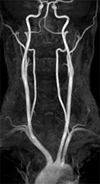FAQs about Magnetic Resonance Angiography
What is MR Angiography?
Magnetic resonance imaging (MRI) is a method of producing extremely detailed pictures of body tissues and organs without the need for X-rays. The electromagnetic energy that is released when exposing a patient to radiofrequency waves in a strong magnetic field is measured and analyzed by a computer, which forms two- or three-dimensional images that may be viewed on a TV monitor. MR angiography (MRA) is an MRI study of the blood vessels. It utilizes MRI technology to detect, diagnose and aid the treatment of heart disorders, stroke, and blood vessel diseases. MRA provides detailed images of blood vessels without using any contrast material, although a special form of contrast material is often given to make the MRI images even clearer. The procedure is painless, and the magnetic field is not known to cause tissue damage of any kind.
What are some common uses of the procedure?
- MRA is a very useful way of finding problems with blood vessels and determining how to best to treat those problems
- The carotid arteries in the neck that conduct blood to the brain are a common site of atherosclerosis, which may severely narrow or block off an artery, reducing blood flow to the brain and even causing a stroke. MRA shows these narrowed areas (stenosis) very precisely without causing any discomfort to the patient.
- MRA has found wide use in checking patients for diseased intracranial (in the head) arteries, so that only those with positive findings will need to undergo more invasive exams or surgery.
- MRA is also used to detect disease in the aorta and in blood vessels supplying the kidneys, lungs and legs.
- Patients with a family history of arterial aneurysm (ballooning out of a segment of the vessel wall) can be screened with MRA to see if they have a similar disorder that has not produced symptoms. If an aneurysm is found, it may be eliminated surgically, possibly avoiding serious or fatal bleeding.
How should I prepare for the procedure?

It is imperative that we know about any metal objects in the body, such as a heart pacemaker, intrauterine device, vascular access port, metal plate, pins, screws or staples. You will be given a questionnaire to answer regarding these issues. The radiologist or technologist should know about any such item and also whether you have ever had a bullet in your body, whether you ever worked with metals, or if you have had a joint replacement. If there is any question, an X-ray can be taken to detect metal objects. The radiologist should also know if you have fillings in your teeth, which could distort images of the facial region or brain. Braces make it harder to properly adjust the MRI unit. You will be asked to remove hairpins, jewelry, eyeglasses, hearing aids and any dental work that can be taken out. Some wigs contain metal and must be removed. Red dyes used in tattoos and permanent eyeliner may contain metallic iron, but this is rarely a problem. You should report any drug allergies to the radiologist or technologist and should mention if there's any possibility that you might be pregnant.
You can eat normally before the exam (unless told differently). Medications may be taken as usual.
Click here if you need to know more information about your exam


